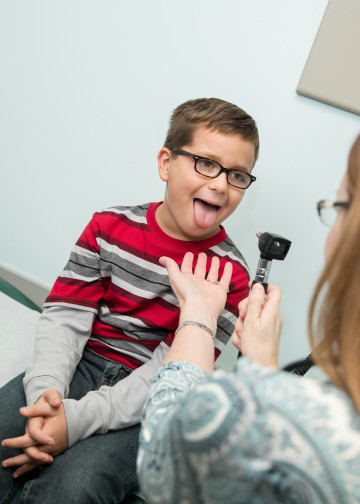Allergies & Children
Allergies are an overreaction of the immune system to substances in the environment that are normally considered harmless — the immune system misidentifies these substances and attempts to fight them off. These substances, or allergens, can cause sneezing, coughing and itching. Allergic reactions range from merely bothersome to life-threatening. Some allergies, like hay fever, are seasonal. Allergies have also been associated with chronic conditions like sinusitis and asthma.
Here are some things to consider if you suspect your child may have allergies:
Genetics. Allergies run in families. For couples where neither parent has allergies, the odds are one in 10 that their baby will develop an allergy. For couples where one or both parents have an allergy, the odds are seven in 10 that their baby will develop an allergy.
Pets. Household pets, whether they are furry or short-haired, can cause your child to sneeze and wheeze. Saliva, urine, fur and dander (dead skin cells) can cause allergic reactions.
Skin. Allergy symptoms may appear as eczema, which are dry, red, scaly patches that itch, or hives, which are red welts on the skin that range in size from tiny dots to very large.
Breathing. If you notice your child experiencing rapid breathing, wheezing, shortness of breath or a dry, hacking cough with clear mucus, hay fever or allergies may be involved.
Allergy or Illness? Runny, itchy, red or swollen eyes and/or a stuffy nose that lasts beyond a week or two may be symptoms of hay fever, or allergic rhinitis, the most common form of allergy among children. If symptoms appear at the same time of year each year, they are likely to be caused by an allergy.
Tummy Trouble. Allergies can cause intestinal symptoms, such as stomach cramps or repeated attacks of diarrhea, in children. Other symptoms include headaches, excessive fatigue and/or unusually crabby or restless moods.
Ask the Doctor. Share your concerns with your child's pediatrician, who can help determine whether your child’s symptoms are allergy-related and what actions, if any, need to be taken.
Anaphylaxis
Early detection and appropriate interventions can help decrease the negative impact of allergies on quality of life. Anaphylaxis is a very rapid, severe allergic reaction that can be life-threatening if untreated. Food, latex, insect stings and drug allergies can all result in anaphylaxis. Symptoms of anaphylaxis include:
- flushed skin
- tingling of the palms of the hands, soles of the feet or lips
- light-headedness
- tightness in the chest
Seek immediate medical attention for these symptoms. They can progress into seizures, cardiac arrhythmia, shock, respiratory distress and even death.
Food Allergies
Food allergies, especially allergies to peanuts, are on the rise. Food allergies generally develop early in life, but can develop at any age. Children usually outgrow their egg, milk and soy allergies, and recent studies have shown 20 percent of children may even outgrow a peanut allergy. According to the US Centers for Disease Control and Prevention (CDC), an estimated 1 in 13 children are affected by food allergies.
These eight foods cause more than 90 percent of food allergies in both children and adults:
- Wheat
- Milk
- Peanuts
- Fish
- Soy
- Eggs
- Tree Nuts
- Shellfish
Symptoms of Food Allergy
Someone allergic to a particular food may experience all or some of the following symptoms:
- Itching inside the mouth
- Swelling of lips and tongue
- Tightening of the throat or trouble breathing
- Vomiting, diarrhea, abdominal cramps and/or pain
- Hives
Prevention
There is no cure for food allergies. The best ways to prevent the symptoms of food allergy include:
- Avoid the food that causes them and/or remove them from your diet.
- Read the list of ingredients on the labels of prepared foods that you are considering eating. Many allergens, such as peanuts, eggs and milk, appear in prepared foods that you normally would not expect.
- Cleanliness can remove most allergens from the environment. Simply washing your hands with soap and water will remove peanut allergens, and most household cleaners will remove allergens from surfaces.
Food Allergies at School
The prevalence of food allergies in children increased 18 percent from 1997 to 2007, and most schools have at least two students with a food allergy, according to the CDC. To address the needs and health of children with food allergies, the CDC released the Voluntary Guidelines for Managing Food Allergies in Schools and Early Care and Education Centers. These guidelines may be helpful if you are concerned about your child's allergy and the food being served at school.
For more information, please call 304.691.1300.
